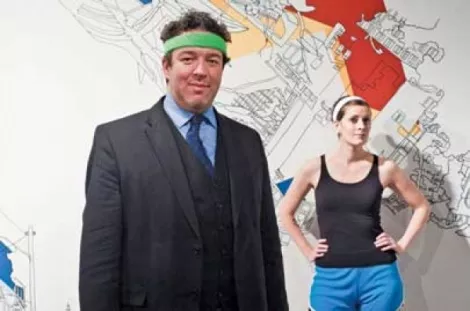
- Niki Chan
- Adam Price and “Hartford/Fiction (combination)” by artist Kim Schoenstadt
You won’t get buns of steel at the Utah Museum of Contemporary Art’s Art Fitness Training, but you’ll be able to train your mind to become a contemporary-art-discerning machine. Executive director Adam Price (pictured with a UMOCA staff member in front of “Hartford/Fiction (combination)” by artist Kim Schoenstadt) talks about the program, which will take place on three consecutive Saturdays, starting Jan. 28. Visit UtahMOCA.org/Art-Fitness to register and for more information.
With your background as a lawyer, is this something you did yourself?
Yes, and I’m definitely not fit. This program was developed by the Museum of Contemporary Art Denver, and they’ve had a lot of success. I went through the training.
Not having any formal training otherwise, I’m always thinking about how [UMOCA] can make the general public feel welcome here and engage with the art to have a meaningful, exciting and thought-provoking experience without that feeling of anxiety. I think Utahns generally have more experience with traditional landscapes than contemporary art, and they don’t necessarily feel like they’ve been given the tools to understand it. That’s what this is about: showing them they already have all the tools they need.
Is this training like those 8 Minute Buns DVDs—you buy them excitedly, get kinda toned ... but, ultimately, the flab returns?
I think the difference is that you stop doing the tapes because they aren’t engaging. If you want to lose weight, it’s better to take up a sport you enjoy than doing the most strenuous exercise. I think people will become empowered and continue to enjoy contemporary art with Art Fitness.
So, when do I get to wear a leotard?
You can come dressed in anything you want. The trainers will probably be in sweat clothes. It’s a little tongue-in-cheek. Although the substance of the program is quite serious, I think there’s room for humor in contemporary art. This is part of lowering the barrier to entry.
What does the training entail?
The heart of Art Fitness Training is hard work. In general, people look at a piece of visual art for about 20 seconds, then spend 40 seconds reading the label, then another five seconds looking at the art. The entire experience is just over a minute, and that’s mostly reading! In Art Fitness, we’ll spend 20 or 30 minutes with one piece—thinking about it and talking about it. The process is about learning to slow down, which is what you’d do with a book or movie.
The first part is to get people out of historically contextualizing artwork. We want to get them answering the questions: “What do you see? What are the colors, shapes, textures, images?” The second part is thinking about how the work could have been different. One thing people struggle with is the idea that art is a work of genius that springs full-blown from the head of the artist and it could be no other way. In fact, a lot of art is problem solving—there are a lot of contingencies and choices as an artist works toward the final project. If people ask this, there’s a subtle critique going on. The third part is asking why the artist made the specific choices they did.
The hope is that if you spend the time to do that with a group of people, and do it three times, you really start to believe that you have the ability to look at any work of art. We do this in three sessions to get people into that rhythm. It gets easier each time.
Why would someone who has reached adulthood without developing an appreciation for art need to change that?
Because contemporary art is awesome. Some of the work in this field is life-changing—the kind of thing you will take with you the rest of your life. More frequently than you’d ever guess, you wind up thinking back to that experience and relate it to your life as you’ve lived it. Particularly because contemporary art is the art of today, and it is speaking to issues, themes and ideas and using materials that are part of our everyday lives. It really does have that opportunity to absolutely create these incredible epiphanies.
You say that interpreting, understanding and enjoying contemporary art can be done with skills that we already possess. But doesn’t that negate one of the most important parts of art post-1960: the historical context? This is not learned in a quickie workout sesh.
There are a lot of ways to think about what art is. Well, American museums have been spoon-feeding patrons too much, with audio- and docent-led tours. When people go around without those inputs, they shrug their shoulders and think they don’t know anything about the history of art, so they can’t appreciate this, therefore they can’t understand this.
The training is really about re-orienting ourselves. One thing that’s important about art is not what’s esoteric in it or what’s in the mind of the artist or curator—those are all things that can add another level of appreciation. Fundamentally, it’s an object, and you have the ability to look at it and perceive that object without any of the knowledge on a broader scope and, therefore, develop your own rich meaning of the work.